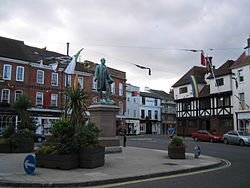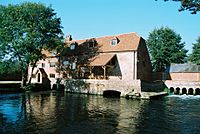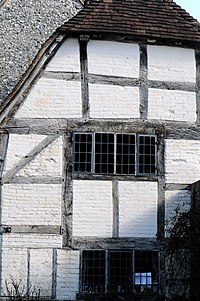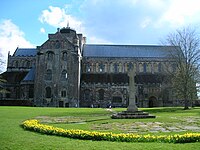Romsey
| Romsey | |
| Hampshire | |
|---|---|
 Romsey town centre | |
| Location | |
| Location: | 50°59’20"N, 1°29’48"W |
| Data | |
| Post town: | Romsey |
| Postcode: | SO51 |
| Dialling code: | 01794 |
| Local Government | |
| Council: | Test Valley |
| Parliamentary constituency: |
Romsey and Southampton North |
| Website: | Romsey Town Council |
Romsey is a small market town in Hampshire. A large Norman abbey, Romsey Abbey, dominates the centre of the town. The town stands on the River Test, which is famous for fly fishing, predominantly trout.[1]
The town is eight miles northwest of Southampton and 11 miles southwest of Winchester, neighbouring the village of North Baddesley. Just over 15,000 people live in Romsey.
Romsey was home of the 20th-century soldier and statesman Lord Mountbatten of Burma, the 19th-century Prime Minister Lord Palmerston, and the 17th-century philosopher and economist William Petty.
The name Romsey is believed to have originated from the term Rumes Eg, meaning "Rum's island" (land surrounded by marsh), or "roomy island". If Rum is a name, it may be an abbreviated form (as a prefix it means "glorious" but is otherwise unknown.
Contents
History
Middle Ages
What was to become Romsey Abbey was founded in 907. Nuns, led by Elflaeda daughter of Edward the Elder, son of Alfred the Great, founded a community — at his direction — in what was then a small village. Later, King Edgar refounded the nunnery, about 960, as a Benedictine house under the rule of St. Ethelflaeda whose devotional acts reputedly included chanting psalms while standing naked in the cold water of the River Test.
The village swelled alongside the religious community. The Vikings sacked Romsey in 993, burning down the church. But the village recovered, and the abbey was rebuilt in stone in about 1000. The religious community flourished as a seat of learning, especially for the children of the nobility. A market was established outside the abbey gates.
The Normans built the large current abbey that dominates the town (between c. 1120 and 1140) on the site of the original Saxon church. By 1240, 100 nuns lived in the convent.
King Henry I granted Romsey its first charter. This allowed a market to be held every Sunday, and a four-day annual fair in May. In the 13th century, Henry III permitted an additional fair in October.
The lucrative woollen industry appears to have powered Romsey's growth during the Middle Ages. Wool was woven and then fulled or pounded with wooden hammers whilst being washed. It was dyed, and then exported from nearby Southampton.
Romsey continued to grow and prosper until plague struck the town in 1348-9. The Black Death is thought to have killed up to half of the Romsey's population of 1000. The number of nuns fell as low as 19. Prosperity never returned to the abbey. It was finally suppressed by Henry VIII during the Dissolution of the Monasteries in 1539. Many religious buildings were destroyed during this time.
Early Modern Period
After the Dissolution, the abbey was saved from demolition because part of it was a parish church for the people of Romsey. The town purchased the abbey from the Crown for £100 in 1544. Ironically, the part of the abbey that had saved the abbey, the church of St Lawrence, was then demolished.
By the mid-16th century Romsey's population was about 1,500; its woollen and tanning industries fuelled growth. On 6 April 1607 King James I granted the town a charter making it a borough. This gave official status to an informal local government that had been running the affairs of the town since the Dissolution of Romsey Abbey in 1539. Romsey could now have a corporation comprising a mayor, six aldermen and twelve chief burgesses, with a town clerk for 'office work'. Furthermore, there was to be a local law court under a Court Recorder, assisted by two sergeants-at-mace. Over all, was the prestigious position of High Steward, the first of whom was the Earl of Southampton. (Lord Brabourne, grandson of Lord Mountbatten of Burma, is the current High Steward.)
Romsey changed hands several times during the English Civil War. Both Royalist and Parliamentary or Roundhead troops occupied and plundered the town. Royalists remained in control of the borough until January 1645.
18th to 20th centuries
The town's woollen industry survived until the middle of the 18th century, but was beaten by competition from the north of England. However, new fast-growing enterprises soon filled the gap with brewing, papermaking and sackmaking, all reliant upon the abundant waters of the Test.
By 1794 a canal connected Romsey to Redbridge — at the mouth of the River Test — and Andover to the north but within 50 years had largely fallen into disuse. Industry continued to grow. Romsey was a reasonably large town for the early 19th century: its population was 4,274 in the first census of 1801, compared with just 8,000 for Southampton.
Despite the arrival of the railway in 1847 the expansion slowed and whilst its population had grown to 5,654 in 1851 it then stagnated and by the time of the census half a century later (1901) the population was just 5,597.
Lord Palmerston, the 19th-century British Prime Minister, was born and lived at Broadlands, a large country estate on the outskirts of the town. His statue stands in the Market Place outside the Town Hall.
The Willis Fleming family of North Stoneham Park were major landowners at Romsey from the 17th until early 20th centuries, and were lords of the manors of Romsey Infra and Romsey Extra.[2]
Romsey was famous for making collapsible boats during the 19th and early 20th centuries, invented by the Rev Edward Lyon Berthon in 1851. The Berthon Boatyard in Romsey made the boats from 1870 until 1917. They were used as lifeboats on ocean-going liners.
Broadlands later became the home of Louis Mountbatten, 1st Earl Mountbatten of Burma, known locally as "Lord Louis". He was buried in Romsey Abbey after being killed in an IRA bomb explosion in Ireland on 27 August 1979. In 1947, Mountbatten was given his earldom and the lesser title "Baron Romsey, of Romsey in the County of Southampton".
After Lord Mountbatten of Burma died, his titles passed to his elder daughter, Lady Brabourne, who thus became Lady Mountbatten of Burma. Her eldest son was styled by the courtesy title "Lord Romsey" until he inherited the title of Lord Brabourne in 2005.[3]
Embley Park, a country estate located on the outskirts of Romsey was the home of Florence Nightingale, most famous for her pioneering work as a nurse and sanitary reform during the Crimean war and for laying the foundation of modern nursing. Florence is said to have had her calling from God whilst being sat under a giant cedar tree in the grounds of Embley Park on 7 February 1837. The site is now home to a private school, reminders of Florence's formative years are all around the house and estate.[4]
Nightingale is buried in the family vault at St. Margaret Church in East Wellow, located on the outskirts of Romsey. Her coffin was taken by train from London to Romsey Station where a horse-drawn carriage completed the journey to the church for a simple funeral at the request of Florence.[5]
During 2007 Romsey celebrated the 400th Anniversary of the granting of its Charter by King James I with a programme of events from March through September, including a visit on 8 June from the Queen and the Duke of Edinburgh.[6] Subsequently. the cost of the visit has created some local political controversy.[7]
Present
Romsey today appears to be in sound economic health. Whilst there is significant commuting out of the town for work - particularly to Southampton and Winchester, and also, to some extent, London - it could not be described as a dormitory town.
Whilst heavy industry in the town has long since declined, three industrial and trading estates focus mainly on service industries and small-scale manufacturing. Three major scientific and high technology employers —Roke Manor Research, Southampton Science Park and IBM — have large establishments in the nearby countryside.
The renovated town centre contains a Waitrose supermarket, a small department store, and over 100 other retail outlets of various kinds, including both high street chains and local independent shops.
There is concern about the decline of local independent shops due to the high business rates, and threat from large supermarkets, which may be increased as Tesco unveiled plans in January 2012 to build an out of town supermarket on six acres of leased land on the Broadlands Estate.[8]
Mills and milling
Watermills have played an important part in Romsey's history as an industrial town. The Domesday Book of 1086 provides the earliest record of watermills in Romsey, which identifies three (possibly four) mills.
Sadler's Mill is probably the best known of Romsey's surviving mills and is apparently the only mill to be developed on the main course of the River Test. The existence of Sadler's Mill is first recorded in the 16th century, when it was owned by the manor of Great and Little Spursholt. Functioning as a corn and grist mill, it has passed through a succession of owners including Lord Palmerston who rebuilt it in 1747 and sold it in 1777 to one Benjamin Dawkins. Following another succession of owners it returned to the Broadlands estate in 1889. Milling ceased in 1932, when the mill building became redundant. The Broadlands estate sold the building in 2003, at which point it was close to collapse having been derelict for many years. The new owners, Anthony and Sarah de Sigley, restored the building in 2005, rebuilding much of the original structure. During the restoration evidence of an earlier structure was found; Radiocarbon dating|carbon 14 dating established the age of this to be circa 1650.
Notable buildings
Romsey Abbey
Romsey Abbey is a Norman abbey, originally built as a Benedictine foundation, housing a community of Benedictine nuns. The abbey is open daily to visitors as well as being the Anglican Parish church of Romsey.
King John's House
King John's House & Tudor Cottage was allegedly a hunting lodge used by King John whilst hunting in the New Forest. However, the existing building dates from much later. It does contain a number of extremely unusual and exciting historical features, including mediæval wall decorations and graffiti, as well as a floor made of animal bones.
Places of interest nearby
- Broadlands - Stately home
- Sir Harold Hillier Gardens - Gardens and arboretum
- Mottisfont Abbey - National Trust property with nationally renowned rose collection
- Paultons Park - Children's theme park
- Romsey Rapids - Leisure pool and gym
Events
The Mayor's Picnic takes place in early-mid summer and is held in Romsey's Memorial Park. There is music performed by local schools, a variety of stalls, and the popular Duck Race, in which numbered plastic ducks 'race' each other along the river Test, to be scrupulously retrieved before awarding a prize to whoever chose the winning duck.
The Beggars Fair is held in the streets and pubs of Romsey on the second Saturday in July. It is a free festival featuring all types of music, together with dance and other street entertainment.
Romsey Carnival takes place during a week in July with the highlight being the procession through the streets of Romsey on the final Sunday afternoon.
The Romsey Show is a large agricultural show that takes place every September at Broadlands. The show is one of the oldest in England, held annually since 1842. In addition, Broadlands has twice hosted the CLA Game Fair, the largest agricultural show in the world, most recently in July 2006.
The Winter Carnival takes places each year when Romsey's Christmas lights are switched on.
The Romsey Arts Festival occurs every 3 years, showcasing talent from in and around the local area.
Romsey Charter Celebrations 1607-2007 Programme of Events ran from 21 March to 30 September 2007.
Romsey Classic Car Show is a charity event that has been running on Boxing Day since 2002, attracting hundreds of pre-1976 vehicles to the town centre car parks.
Sport and leisure
- Football: Romsey Town FC, who play at The Bypass Ground, South Front.
- Rugby: Romsey Rugby Football Club, based at Romsey Sports Centre
The town contains a swimming pool, the Romsey Rapids.
Amdram
The local amateur dramatics group, Romsey Amateur Operatic and Dramatic Society (RAODS) is highly unusual in owning its own fully equipped 230-seat theatre, The Plaza, in which it stages about ten productions each year. The Plaza, previously a cinema in the 1930s and then a bingo hall until the 1980s, is also hired out for other local productions, concerts, and functions.
Media
- Newspaper:The Romsey Advertiser, published every Friday.
Miscellaneous
The body of King William II "Rufus" was carried through Bell Street in Romsey on its way to Winchester, after he had been killed whilst hunting in the New Forest.
The town's memorial park contains a Japanese Second World War artillery gun, one of a pair captured by the British and brought back to Romsey by Lord Mountbatten of Burma. One was donated to the town by Lord Mountbatten, and the other was retained in the grounds of his country estate, Broadlands.
In the 1980 and 1990s, Romsey was used as the location of 'Kingsmarkham' in the television series The Ruth Rendell Mysteries. Numerous Romsey locations appear throughout the series concerning Inspector Wexford played by George Baker. For example, the location used for the fictional police station was in fact the former Romsey Magistrates Court in Church Street.
In the "New Year's" episode of the BBC comedy Absolutely Fabulous (1995), Patsy Stone and Edina Monsoon are discussing a New Year's Eve Party to which they have been invited and is so posh and exclusive that its whereabouts are unknown to all but the rich and famous. Patsy finally reveals it to be located in "an underground car park in Romsey." There is no underground car park in Romsey.
Outside links
| ("Wikimedia Commons" has material about Romsey) |
- Hampshire County Council page on the town
- RomseySchools.net Information on all schools in Romsey
References
- ↑ Environment Agency (2006).Fact file on the River Test Retrieved 2007-11-03
- ↑ The Romsey Estates of the Wilis Fleming family
- ↑ BBC News (2005).Death on the Nile producer dies Retrieved 2007-11-01
- ↑ Florence Nightingale's home at Embley Park near Romsey BBC News, 5 May 2010
- ↑ http://www.countryjoe.com/nightingale/funeral.htm
- ↑ BBC News (2007).Queen marks charter anniversary Retrieved 2007-11-01
- ↑ BBC News (2007).Town left with royal toilet bill Retrieved 2007-11-03
- ↑ "Is the Future of Romsey Under Threat from the new Core Strategy and Tesco?". Inspired Community. http://www.inspiredcommunity.co.uk/blog/future-romsey-under-threat-council%E2%80%99s-core-strategy-and-tescos. Retrieved 26 January 2012.


